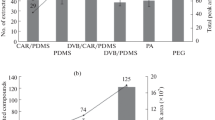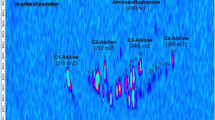Abstract
We propose a new method for the rapid determination of five volatile compounds described in the literature as possible biomarkers of lung cancer in urine samples. The method is based on the coupling of a headspace sampler, a programmed temperature vaporizer in solvent-vent injection mode, and a mass spectrometer (HS-PTV-MS). This configuration is known as an electronic nose based on mass spectrometry. Once the method was developed, it was used for the analysis of urine samples from lung cancer patients and healthy individuals. Multivariate calibration models were employed to quantify the biomarker concentrations in the samples. The detection limits ranged between 0.16 and 21 μg/L. For the assignment of the samples to the patient group or the healthy individuals, the Wilcoxon signed-rank test was used, comparing the concentrations obtained with the median of a reference set of healthy individuals. To date, this is the first time that multivariate calibration and non-parametric methods have been combined to classify biological samples from profile signals obtained with an electronic nose. When significant differences in the concentration of one or more biomarkers were found with respect to the reference set, the sample is considered as a positive one and a new analysis was performed using a chromatographic method (HS-PTV-GC/MS) to confirm the result. The main advantage of the proposed HS-PTV-MS methodology is that no prior chromatographic separation and no sample manipulation are required, which allows an increase of the number of samples analyzed per hour and restricts the use of time-consuming techniques to only when necessary.

Schematic diagram of the developed methodology



Similar content being viewed by others
References
Greenberg AK, Lee MS. Biomarkers for lung cancer: clinical uses. Curr Opin Pulm Med. 2007;13:249–55.
Filipiak W, Sponring A, Filipiak A, Ager C, Schubert J, Miekisch W, et al. TD-GC-MS analysis of volatile metabolites of human lung cancer and normal cells in vitro. Cancer Epidem Biomar. 2010;19:182–95.
Silva CL, Passos M, Câmara JS. Investigation of urinary volatile organic metabolites as potential cancer biomarkers by solid-phase microextraction in combination with gas chromatography-mass spectrometry. Brit J Cancer. 2011;105:1894–904.
Hanai Y, Shimono K, Matsumura K, Vachani A, Albelda S, Yamazaki K, et al. Urinary volatile compounds as biomarkers for lung cancer. Biosci Biotech Bioch. 2012;76:679–84.
He Y, Vargas A, Kang YJ. Headspace liquid-phase microextraction of methamphetamine and amphetamine in urine by an aqueous drop. Anal Chim Acta. 2007;589:225–30.
Rocha SM, Caldeira M, Carrola J, Santos M, Cruz N, Duarte IF. Exploring the human urine metabolomic potentialities by comprehensive two-dimensional gas chromatography coupled to time of flight mass spectrometry. J Chromatogr A. 2012;1252:155–63.
Smith S, Burden H, Persad R, Whittington K, Costello BL, Ratcliffe NM, et al. A comparative study of the analysis of human urine headspace using gas chromatography-mass spectrometry. J Breath Res. 2008;2:037022.
Pérez-Antón A, Casas-Ferreira AM, García-Pinto C, Moreno-Cordero B, Pérez-Pavón JL. Headspace generation coupled to gas chromatography-mass spectrometry for the automated determination and quantification of endogenous compounds in urine. Aldehydes as possible markers of oxidative stress. J Chromatogr A. 2014;1367:9–15.
Del Nogal-Sánchez M, Callejo-Gómez PÁ, Pérez-Pavón JL, Moreno-Cordero B, Crisolino-Pozas ÁP, Sánchez-Rodríguez Á. Sensitivity enhancement in the determination of volatile biomarkers in saliva using a mass spectrometry-based electronic nose with a programmed temperature vaporizer. Anal Chem. 2014;86:7890–8.
Sakura N, Nishimura S, Fujita N, Namera A, Yshiki M, Kojima T. Determination of acrolein in human urine by headspace gas chromatography and mass spectrometry. J Chormatogr B. 1998;719:209–12.
Adiguzel Y, Kulah H. Breath sensors for lung cancer diagnosis. Biosens Bioelectron. 2015;65:121–38.
D’Amico A, Pennazza G, Santonico M, Martinelli E, Roscioni C, Galluccio G, et al. An investigation on electronic nose diagnosis of lung cancer. Lung Cancer. 2010;68:170–6.
Oh EH, Song HS, Park TH. Recent advances in electronic and bioelectronic noses and their biomedical applications. Emzyme Microb Tech. 2011;48:427–37.
Westenbrink E, Arasaradnam RP, O’Connell N, Bailey C, Nwokolo C, Bardhan KD, et al. Development and application of a new electronic nose instrument for the detection of colorectal cancer. Biosens Bioelectron. 2015;65:733–8.
Rudnicka J, Walczak M, Kowalkowski T, Jezierski T, Buszewski B. Determination of volatile organic compounds as potential markers of lung cancer by gas chromatography-mass spectrometry versus trained dogs. Sensor Actuat B-Chem. 2014;202:615–21.
Del Nogal-Sánchez M, Hernández-García E, Pérez-Pavón JL, Moreno-Cordero B. Fast analytical methodology based on mass spectrometry for the determination of volatile biomarkers in saliva. Anal Chem. 2012;84:379–85.
Vera L, Mestres M, Boqué R, Busto O, Guasch J. Use of synthetic wine for models transfer in wine analysis by HS-MS e-nose. Sensor Actuat B-Chem. 2010;143:689–95.
Cozzolino D, Cynkar W, Dambergs R, Smith P. Two-dimensional correlation analysis of the effect of temperature on the fingerprint of wines analysed by mass spectrometry electronic nose. Sensor Actuat B-Chem. 2010;145:628–34.
Chen H, Pan Z, Talaty N, Raftery D, Cooks RG. Combining desorption electrospray ionization mass spectrometry and nuclear magnetic resonance for differential metabolomics without sample preparation. Rapid Commun Mass Sp. 2006;20:1577–84.
Huang J, Kumar S, Abbassi-Ghadi N, Španĕl P, Smith D, Hanna GB. Selected ion flow tube mass spectrometry analysis of volatile metabolites in urine headspace for the profiling of gastro-esophageal cancer. Anal Chem. 2013;85:3409–16.
Jaffe M. Ueber den Niederschlag, welchen Pikrinsäure im normalen Harn erzeugt und über eine neue Reaction des Kreatinins. Z Phys Chem. 1886;10:391–400.
Delanghe JR, Speeckaert MM. Creatinine determination according to Jaffe—what does it stand for? Nephrol Dial Transpl. 2011;4:83–6.
Enhanced ChemStation, MSD ChemStation E.02.00493, Agilent Technologies: 2008.
The Unscrambler v10.2; Camo Process AS: 2012.
OriginPro v8.0724; OriginLab Corporation: 2007.
Blanco M, Castillo M, Peinado A, Beneyto R. Determination of low analyte concentrations by near-infrared spectroscopy: effect of spectral pretreatments and estimation of multivariate detection limits. Anal Chim Acta. 2007;581:318–23.
Acknowledgments
The authors wish to thank Spain’s Ministry of Economy and Competitiveness for funding Project CTQ2013-47993-P/BQU and the Junta de Castilla y León for Project SA162U14. A. Pérez Antón is also grateful to the Spanish Ministry of Education, Culture and Sports for a research fellowship.
Author information
Authors and Affiliations
Corresponding author
Ethics declarations
Conflict of interest
The authors declare that they have no conflict of interest.
Informed consent
Informed consent was provided by all the individuals involved in the study.
Ethics approval
The study was authorized by the Hospital Ethics Committee.
Electronic supplementary material
Below is the link to the electronic supplementary material.
ESM 1
(PDF 22 kb)
Rights and permissions
About this article
Cite this article
Pérez Antón, A., Ramos, Á.G., del Nogal Sánchez, M. et al. Headspace-programmed temperature vaporization-mass spectrometry for the rapid determination of possible volatile biomarkers of lung cancer in urine. Anal Bioanal Chem 408, 5239–5246 (2016). https://doi.org/10.1007/s00216-016-9618-5
Received:
Accepted:
Published:
Issue Date:
DOI: https://doi.org/10.1007/s00216-016-9618-5




